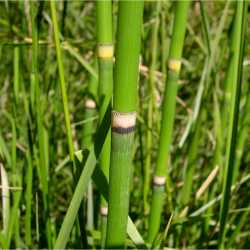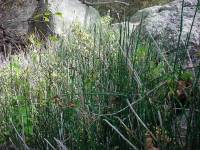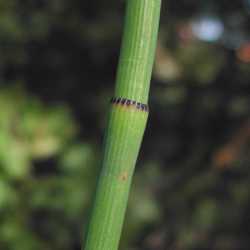PLANT: Perennial herbs with branched rhizomes.
RHIZOMES: deep-seated, often dark brown to purplish black, usually with nodal sheathes similar to the aerial stems, these becoming degraded with age.
ROOTS: adventitious, often branched.
AERIAL STEMS: unbranched or with whorls of branches, sometimes irregularly branched following flood damage, hollow (except at nodes), with a larger central longitudinal canal and 2 rings of smaller canals, those under the ridges (carinal canals) and those between the ridges (vallecular canals). the nodes jointed.
LEAVES: whorled, fused into short sheaths at the stem nodes, the tooth-like free tips brown to black, concolorous or bicolorous with a green to white midvein or white margins, persistent or shed early.
STROBILI: cone-like, with peltate sporophylls, borne at the stem and/or branch tips, green or the sporangiophores sometimes brownish- to blackishtinged, the strobilus tip rounded or sharply mucronate.
SPORANGIA: in a ring of 5-10 along the undersurface of sporophylls, saclike, dehiscing by a lateral slit.
SPORES: monomorphic, globose, green, bearing 4 linear-spatulate, white structures (elaters).
GAMETOPHYTES: surficial, irregularly disk-shaped, green, usually fünctionally unisexual.
NOTES: l genus, 15 spp., nearly worldwide. The strobili of Equisetum are complex structures. The highly modified sporophylls are tightly spiraled and oriented at right angles to the central axis. The outer surface of the strobilus appears as a series of interlocking hexagonal plates, which separate at maturity through elongation of the central axis. The mass of spores appears as minute green globes (visible with a hand lens) immersed in a cottony mass of elaters. The elaters spread as they dry and coil around the spores when wetted. This complex reproductive morphology notwithstanding, much of the reproduction in Equisetum species is vegetative from rhizome and aerial stem fragments dispersed by flood-waters or perhaps in mud on the feet and feathers of waterfowl.
REFERENCES: Yatskievych, G. and M.D. Windham. 2008. Vascular Plants of Arizona: Equisetaceae. CANOTIA 4 (2): 41-45.
Rhizomatous colonial perennials with annual or perennial green stems, the epidermis with silicified cell walls and often with regularly arranged silicified projections, so that the surface is minutely rough to the touch. 2n=216 or nearly so. 15, cosmop. Sterile but vegetatively vigorous and persistent hybrids are often produced between species of the same subgenus. Some of these are: E. ئerrissii Clute = E. hyemale נlaevigatum; E. جitorale K










